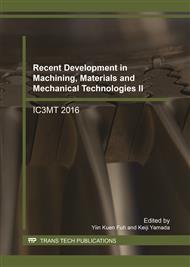p.171
p.178
p.185
p.191
p.199
p.205
p.211
p.217
p.223
Production of Cemented Carbide-Alumina Composite Material by Wet-Shaping Process
Abstract:
In this study, the characteristics of the production process of cemented carbide-alumina composite material made using the wet-shaping process were investigated. The production process in this study produced a green compact of composite material by repeating the wet-shaping process for the molding of each material, and it made possible the sintering of plural materials with varying sintering conditions at the same time, a process that was difficult until now. By using wet-shaping and ultra-fine powder, which have superior sintering characteristics, sintering conditions were found in which it was possible to sinter cemented carbide and alumina at the same time, with a sintering temperature of 1723 K and a sintering time of 5.4 ks. With these sintering conditions, the relative densities of the sintered compact of cemented carbide and alumina were 99.0 % and 98.9 %, respectively. It is clear that the characteristics of sintered compact made with these sintering conditions are superior. When the cemented carbide slurry and the alumina slurry were layered by repeating the wet-shaping process, a composite material was able to be produced by inserting an active brazing filler metal in the interface to improve the bondability of the cemented carbide and the alumina during the sintering. However, it was observed that the active brazing filler metal and the cobalt in the cemented carbide flowed out from the interface between the cemented carbide and the alumina in the sintered compact of the composite material.
Info:
Periodical:
Pages:
199-204
Citation:
Online since:
August 2017
Authors:
Price:
Сopyright:
© 2017 Trans Tech Publications Ltd. All Rights Reserved
Share:
Citation:


